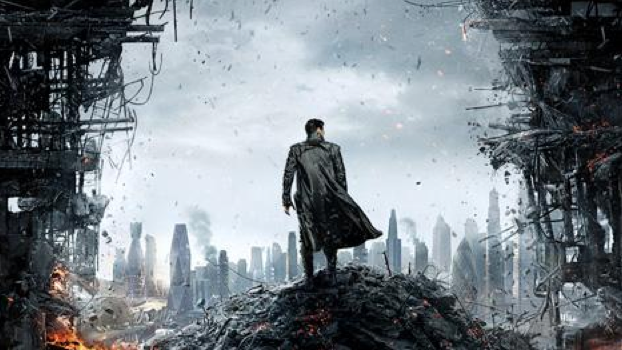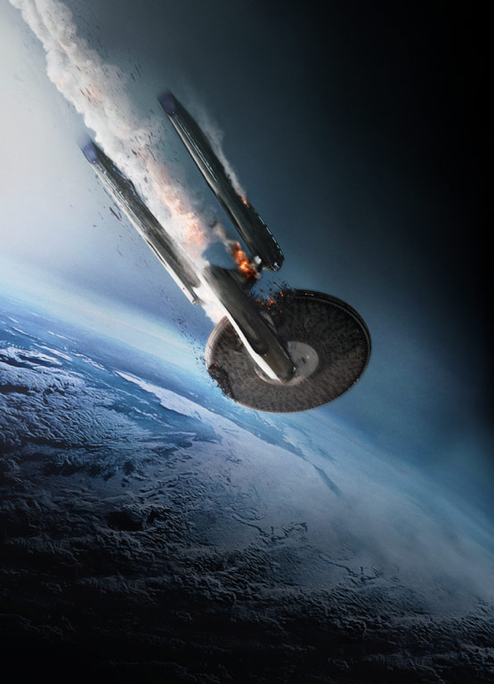 We were expecting a really fun, but perhaps generic sequel, and we got a bit more. Our rating for Into Darkness is 8 out of 10
We were expecting a really fun, but perhaps generic sequel, and we got a bit more. Our rating for Into Darkness is 8 out of 10
As a reminder, we’re using a different scale for our movie reviews (out of 10 rather than being out of 5), and we’ll eventually rank them all. This is the only time we’re going to be reviewing a movie as it comes out, so our feelings about it might change as time goes on. The first chunk of the review will be spoiler free, and then after a spoilers warning we’ll get into specifics.
Characters
With the last movie ending by having Kirk and Spock finally starting to work together, we were all expecting the next step to be showing the characters bonding and becoming best buds. Even though this is a simple enough theme, it’s hard to get across in a way that’s genuine. We were surprised at how well Into Darkness achieved this.
Like with any “team” movie, we can expect each character to be given their time to do something cool. The main thing I look for when writers are trying to do these kind of character moments is if the scenes come naturally, rather than being clearly forced. With the exception of a brief Chekov moment towards the end, the characters have legitimately cool moments that come naturally and make sense.
Fan Service
Perhaps the most controversial part of this movie is its references to the original Star Trek, which we’ll discuss further in the spoiler section. Into Darkness moves beyond fun throw away references and uses big chunks of previous Trek events. Many have complained that Into Darkness is unoriginal or blasphemous in this regard, but we think they re-contextualize events in a purposeful and interesting way to inform how this version of the characters are learning and changing.
Also, something that originated in Deep Space Nine plays a pretty major role in the movie, which we liked.
Action
Like in our review of the 2009 movie, the action-packed nature of the film is worthy of analysis. Action doesn’t bother us, we just don’t like it when it’s pointless and empty action, or if the plot seems to just be an excuse to string a series of unrelated action scenes together. All of the action sequences in this movie flow from the plot, at least more so than in the 2009 movie. For example, in the 2009 movie, the child-Kirk stealing his father’s car, Kirk running around with giant hands, Kirk escaping the red monster on Delta Vega, and Scotty getting stuck in the water tubes didn’t really add anything to the plot. I liked some of those scenes, but it just seemed like they were trying to meet an exciting-beat quota. Into Darkness doesn’t have this issue.
Plot Holes
There are a lot of criticisms floating around the internet about the plot holes Into Darkness has, which is worth noting. The central events and decisions that propel most of the plot forward fall apart upon inspection, which is pretty bad. It’s a problem this group of writers frequently have. Fortunately the plot moves fast enough that its not really a distraction, and the premise that grows out of the inconsistencies provides a genuinely moving portrait of the characters by the end of the movie.
Conclusion (of the non-spoiler section)
It’s fun. The action works. They nailed the theme with Spock and Kirk. There are some big plot holes. The side characters are cool. The villain is done well.
WARNING: SPOILERS BELOW!!
The Wrath of John Harrison
We were convinced it was Khan long before the movie came out, so we had time to prepare for it mentally. Even though Benedict Cumberbatch wasn’t their first choice for the role, we’re glad he got the part. It’s not only because he’s a very good actor, but also because he’s different enough from Ricardo Montalban that it feels less like an infringement on his performance. It’s easier to accept the two Khans. Added to this, the new Khan didn’t really play the same role. They accentuated his pre-existing noble qualities for a believable team up against Section 31, before wheeling back around to his violent, sinister side.
A lot of anger has been directed at Kirk’s “death” scene that parallels Spock’s death at the end of The Wrath of Khan. While we could have done without Spock yelling “Khhaaaan!” the overall idea behind the scene is intriguing and well executed. It flips one of the most famous scenes in Star Trek to comment on the state of Kirk and Spock’s relationship, and the differences from their Prime counterparts. It also provides one of the more emotionally potent scenes in a Star Trek movie, and the culmination of Kirk and Spock’s growth up to that point.
Plot Issues
The plot had the same problem it’s media campaign had with trying to hide the villain’s identity: they would constantly give obvious hints at what was going to happen and I got the feeling they didn’t know how obvious they were being.
When Scotty leaves Enterprise, we know it’s only because he needs to be used off of the ship in the future. When Spock beams the torpedoes over to the enemy ship, his scheme is pretty easy to see through. When Kirk randomly asks Bones “what are you doing with that Tribble?” he might as well have asked “hey, will that come in handy later in the plot?” When Kirk dies, there’s absolutely no threat that he’s actually dead in the mind of the audience. And on the continuity front, is that Praxis that’s all blowed up when everyone goes to Qo’noS? Doesn’t that happen years and years later? These aren’t huge problems because these plot points aren’t meant to be surprises, but it’s generally not a good thing if the audience feels like they’re two steps ahead of the characters.
There are also a number of plot points that don’t make any sense. When Khan is captured by Kirk, why isn’t Khan completely straight forward about what’s going on? It’s almost like he had a secret alliance with JJ Abrams to try and reveal the plot at the right time. He says vague things like “check out these coordinates,” or “why not open one of those torpedoes,” when he should just be saying “Marcus is building a huge war ship, it’s at these coordinates if you want to check it out. Also, there’s people in the torpedoes.” Why does Marcus give the torpedoes to Kirk? He says they’re the only way of killing Khan from a safe distance, but he also apparently wanted Kirk to get stranded and die anyway. If these torpedoes really were the only way of getting Khan, then I guess that’s what Marcus needed to do, but it just seems like it was awfully risky giving Kirk something that could totally expose him without much of a benefit. Why did Khan even go to Qo’noS? Doesn’t he know that plays exactly into Marcus’ plans to start a war? The list goes on, but ultimately it doesn’t bother us too much because most of these don’t stall the momentum of the movie or distract the viewer too much while watching.
9/11
Star Trek often has analogies to political or real world events, usually with a progressive outlook. But what can most likely be attributed to Orci, Into Darkness makes some analogies to drone warfare and 9/11 that are at best unfocused. We suspect (although this maybe brings in too much outside knowledge of Orci) that there are some thematic references to 9/11 being a conspiracy. It’s one fantasy making an analogy to another fantasy. These theories have been so thoroughly discredited that it’s supporters are stubbornly and embarrassingly living in an imaginary past. This is completely contrary to what Star Trek should be about. The good news is that you can watch the entire movie, enjoy it, and never even consider this stupid analogy.
Conclusion
Like many of the Star Trek films, Into Darkness aims to make a big, action packed adventure for the crew of the Enterprise. Unlike a lot of the Star Trek movies (we’re looking at those Next Generation ones in particular) it provides exciting set pieces and great character work.

